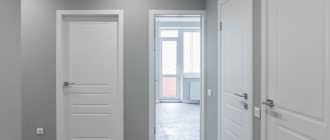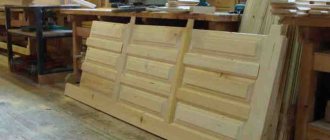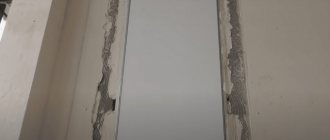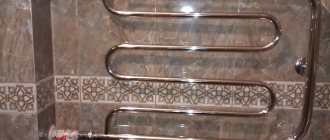Hello readers of my blog! Today we will talk about step-by-step installation of interior doors with your own hands. It would seem that this is not a tricky matter, but when you are faced with this problem, you have to think about how to do it correctly, what preparation to do, what materials to choose. Thus, I decided that this article would be useful to someone, and I am devoting my efforts to this topic. In it I will answer a number of questions that will arise immediately before the step-by-step installation of interior doors with your own hands, and some even after that. This topic is quite broad, because before work, thorough preparation is necessary, but how to do this? And this is a separate topic. You can learn about all this in great detail in the article below.
Do-it-yourself interior door installation
Installing a new door yourself is not at all difficult - if only you had the right tools at hand.
And it’s better to start the experiment with the most inconspicuous doors - for example, to the pantry. We bring to your attention detailed instructions for installing an interior door.
Preparatory work. Before you go to a construction hypermarket or market, determine the budget for the door replacement event. Please note that if you decide to change the doors in the entire apartment, you need to buy them at the same time.
Later, the desired model may be discontinued or there may be no doors of the required shade in stock.
Keep in mind also that an interior door is not just a door leaf!
You will also need a box, accessories, a threshold, platbands, and sometimes handles. The total cost of all this stuff is close to the cost of the canvas itself. If the width of the doorways in your apartment exceeds 110 cm, you will have to either buy a double door (which is more expensive than a single door) or reduce the opening.
In general, carefully calculate the upcoming expenses in order to decide which doors you will buy: solid, veneered or plastic.
Installing the door yourself: step-by-step instructions. Let us immediately note that if you bought expensive solid wood doors, then it is better to install them with the help of specialists.
After all, the cost of possible installation errors is too high. Although if you act carefully, slowly and in strict accordance with our instructions, the risk is small. Remove the old door.
First, use a chisel and hammer to remove the trim. Then use a nail puller or crowbar to lift the door and remove it from its hinges. After that, all that remains is to remove the door fastenings (screws or nails) and remove the frame from the doorway.
Prepare the doorway for installing the new frame.
If there are wooden blocks left in the wall on which the old box was held, then the new one will be attached to them with screws. Otherwise, it is secured with dowels.
Install the new frame into the doorway. Before fixing it in place, check the verticals using plumb lines.
If necessary, drive several wedges between the frame and the wall. Do not forget that the vertical line is set in two planes using a plumb line or level: the door should not go either “forward” or “sideways”.
Secure the box. Drill holes for screws opposite the bars or pre-hammered dowels.
In this case, the through holes should be of the same diameter (the diameter of the screws), and additional holes should be made to a depth of 1 cm with a thicker drill to hide the screw heads and hide these places with plugs. It is enough to secure the side parts with three screws each, and the top with one more.
Hang the door leaf on the hinges. If the box is installed correctly, the door will close tightly and will not open by itself.
Pay attention to the gaps between the box and the canvas: on the left, right and top they should be 2 mm, on the bottom - 4 mm.
Fill the holes between the door frame and the wall with foam. After it dries, install the trim. Do not drive the nails all the way in so that you can bite off the heads.
Install all the necessary fittings: handles, locks, latches, door opening limiters. That's all! Now you know for sure that installing an interior door on your own is not difficult.
Installation of interior doors
Replacing interior doors is not as labor-intensive and complicated a process as it seems. You can fill a double or single opening yourself without the help of a specialist.
Of course, you won’t save time, but you will save money and acquire new skills when renovating an apartment or house.
How to install an interior door: in this article we will tell you how to choose a good door leaf, what the block for filling the opening is made of and how to install it.
Opening measurement
Making a mistake at the stage of measuring the doorway is unacceptable: if you purchase a system of large dimensions, you will not be able to insert it, and if you purchase a smaller one, you will not be able to fix it well.
It is better to measure the doorway after dismantling the old door, when access to the bare wall has appeared.
This way you can assess the situation and make the right measurements. Removing them is simple: take a tape measure and determine the height and width of the entrance along the wall in the narrowest place (relevant for buildings where the vertical structure of the structures is poorly maintained). With this data, go to the store for a new door.
There is no need to make the product according to individual dimensions: in houses with apartments, builders initially lay standard openings, and the fillings for them are always available for open sale.
Interior doors in a private wooden house may differ from the standard ones, then you will have to order new ones and wait for them to be manufactured.
Necessary tool
The next stage of preparation will be preparing the tools that will be needed to make an interior door. You need to have on hand:
- Manual or electric plane;
- Hacksaw or electric jigsaw;
- Set of chisels and chisels;
- Manual electric router;
- Grinding machine;
- Miter box;
- Square and ruler;
- Hammer and mallet;
- Pencil and tape measure.
With this set you can safely start making any carpentry product. You should also prepare a vacuum cleaner to quickly remove not only sawdust, but also dust, which should not end up on the surface of the product during paintwork.
Door selection
The first thing you should pay attention to when choosing canvas and boxes is the material they are made of.
Fiberboard is used to produce budget doors and frames. The material does not protect the room from extraneous sounds, absorbs moisture, and filling will lead to damage during the first off-season.
It is strictly not recommended to choose a frame made of fiberboard; it quickly deforms even under the weight of the door.
MDF is a more reliable material with increased density, average in price-quality ratio.
It is strong enough to withstand mechanical loads, does not absorb moisture, muffles sounds and lasts a long time.
Solid wood is ideal for making and installing a box. It will not be affected by humidity, it will withstand the weight of any door. Laminated wood is additionally lined; untreated timber is not inferior to laminated timber in performance, but it will have to be painted or decorated.
The ideal option is to purchase a box and canvas made of the same material. You should not give preference to wood fiber board; doors made from it are short-lived; they are installed on construction sites so that new owners can replace them with permanent ones made of more durable materials.
Ideally, it is worth acquiring a solid solid material as a door filling; to reduce the cost, the canvas can be replaced with MDF, which is also a durable raw material for the manufacture of cheaper door frames.
Additional strips and trims can be made of fiberboard, wood or MDF. They do not carry a load, they only decorate the gaps and disguise the connections.
Double doors are often chosen for large rooms and halls; single-leaf blocks are installed in bedrooms and kitchens. In any case, the size of the box and the number of panels are determined by the size of the opening.
Step-by-step instructions for installing from scratch
Installing interior doors with your own hands will not take much time, just stock up on the necessary tools, purchase the necessary materials and you can get to work. Follow the detailed step-by-step instructions and you are guaranteed success.
This plan is valid for installing swing doors; sliding doors are mounted slightly differently, but in a similar way.
How to install interior doors with your own hands
It is impossible to imagine any home without interior doors. They perform several functions at once.
Installing interior doors is quite simple and will not cause any particular difficulties even if you do the work yourself. Of course, if you wish, you can use the services of specialists.
Design options
Of course, you understand that the door can have different configurations.
In the case of interior rooms, there are the following options:
- swing;
- recoil;
- folding (accordion);
- cassette;
- sliding door (sliding);
- rotating, etc.
In our case, it is the classic swing door that is of interest. I think we’ll talk separately about how you can make interior sliding doors. Many people will be interested in this.
As for classical swing designs, there is its own classification:
- Paneled
. There are quite thin inserts, that is, panels, in the door leaf; - Shield ones
. This is a frame that is covered with lining material, plywood or laminate, for example. And filler is placed in the voids; - Hollow
. These are the same panel structures, only there is no filler inside.
In fact, the filler improves soundproofing and thermal insulation properties. Not everyone and not always need this. Therefore, it is quite possible to do without filler. Here everyone decides for himself.
Choosing an interior door
In principle, this does not affect the technology of installation work in any way. But their cost depends on the type of door, and the service life of different types of doors differs significantly.
paneled interior doors. If they are made of hardwood, then they can be considered almost a luxury item.
In addition to their main function, they decorate the room. The only disadvantages include high cost and heavy weight. For interior doors, paneled doors are more often used, but made of soft wood;
As for the installation technology, to make the work easier, it is recommended to purchase the door complete with a door frame.
A price that is too low is suspicious. Most likely, in this case, the door is sold without a frame; in the end, this will greatly complicate the installation of the interior door.
Materials used
The product is based on natural wood or its analogues. As for the situation with the box, it is recommended to use the same wood or MDF.
Metal is used to make hinges, handles, embed and insert a lock, and assemble the finished structure in a box.
If it's natural wood, the smartest thing to do is simply open it up with 1-2 coats of clear varnish. Some paint the doors, but then the natural beauty of the wood is hidden. And the point in using expensive material is lost.
Therefore, to finish doors that do not look particularly attractive without coating, lamination, veneering and painting are used.
How to properly install an interior door - step by step
Before installing the door itself, the door frame is installed. If it was purchased together with the door, then most likely its ends are already sawn at an angle of 45°. In this case, all that remains is to assemble the box into a U-shaped structure.
Depending on the configuration, the set may also include an additional strip. It will be used to securely fix the door frame until final installation.
The door frame elements can be connected using either self-tapping screws or plastic dovetail keys. They usually come with a box.
When assembling the box, special attention must be paid to ensure that no element moves relative to the other. Otherwise, all the work will go to waste.
Before installing the door frame, it is advisable to select all the necessary grooves in the wood for awnings, installation of door handles, and a lock. It is much more convenient to do this while the box is not yet installed.
Also, before installing the frame, you need to shorten the side posts along the length of the door. It is important to ensure a gap of 10-15 mm between the door and the floor of the room.
To ensure that the door frame does not deform at the bottom when performing work, an additional strip is placed on the screws.
It needs to be attached to that part of the box that will be hidden after final finishing. The screws are screwed in obliquely so as not to split the wood.
There must be a gap between the frame and the doorway; wooden wedges will be driven into it for temporary fixation, then the free space will simply be filled with foam. But this will happen after the final fitting of the door.
First, the door frame is attached to the wall with a self-tapping screw or dowel only in the upper part. Moreover, the mounting location should be in the groove for the canopy. Then the canopy will play the role of a decorative overlay.
After fixing the top of the box, its bottom is carefully controlled, then, using the same principle, fixation is performed from below. Additionally, the box is secured using wedges, which are driven in at the top at the level of the crossbar and at the bottom at the level of the temporary spacer.
This is followed by fitting of the door; the frame is not yet fully secured.
The door is hung and the smoothness of movement and the verticality of the door itself are checked. Sometimes, even with careful adherence to technology, the door itself opens or closes, which indicates a slight vertical deviation. In this case, additional adjustment of the position of the door frame will be required.
If everything is in order, then you can fill the voids between the door frame and the wall with foam.
Before doing this, it is better to insulate with masking tape all wooden surfaces that may come into contact with the foam. It will be very difficult to remove it later without damaging the tree.
To ensure maximum adhesion, concrete must be cleaned of dust and dirt.
After foaming the voids, you must take a break for 12 hours. Then the excess foam is cut off with a knife and installation of the trim and trim begins.
The additional strip should cover the distance from the edge of the wall to the door frame. It can be attached to the box with self-tapping screws, and the planks are connected to each other (if you need to use several panels in width) using a tongue-and-groove pattern. Existing voids also need to be filled with polyurethane foam.
After this, all that remains is to attach the platbands. At the joints they are sawed at an angle of 45°.
Platbands can be attached either with glue or with ordinary nails without a head. Platbands with a special protrusion are also produced, which are simply inserted into the corresponding groove on the door frame. In this case, you can do without nails and use only glue.
At this point, the installation of interior doors with your own hands can be considered complete. If the described technology is followed, the quality of the installation will be comparable to the work of professionals.
Installation of interior doors
The instructions for installing interior doors allow you to install such structures yourself without much difficulty. You just need to strictly follow its points.
Special mounting kits
New technologies have ensured the availability of ready-made kits for fastening doors, which makes the process easier and faster, even if a non-professional takes on the job. You can purchase Russian products. The kit includes a set of fasteners and a step-by-step guide. The set includes two halves of the product. One is attached to the opening, the second - to the inner surface of the frame beam.
When combining products, it is possible to adjust the frame, even if the door is already installed. Adjustment manual or power tool. The kits provide for deep mounting, but do not require drilling through the box. This preserves the decorative coating.
The kit includes all the necessary accessories; you don't need to buy anything else. Special fastening kits are suitable for fixing doors into openings made of concrete, wood, brick, foam concrete and other materials.
Do-it-yourself door installation - let's evaluate the scope of upcoming work
Door structures between rooms in an apartment or private house cannot be called very complex technical systems. However, their assembly and installation require knowledge of a number of nuances.
- Firstly, a door installed by yourself should not open spontaneously.
- Secondly, it must close without excessive effort.
- Thirdly, door structures must have a certain strength and not fall apart in cases where they are installed in the homes of “lovers” of slamming doors.
A regular door block consists of two elements – the leaf and the frame.
The latter is made of loop and false beams, as well as a lintel. If you install doors with a threshold, the frame is supplemented with a special bottom bar. In most cases, the door leaf is hung on two hinges.
There are systems with three loops, but they are used extremely rarely. The set of door blocks, as a rule, includes platbands. If the manufacturer does not provide these, you will need to purchase them separately.
In situations where the door frame is smaller in width than the door opening, you need to purchase additional panels or trim the walls with strips or more elegant slopes from a design point of view. Here you need to know that professionals do not recommend plastering slopes if you are installing structures made from wood materials (for example, MDF) with your own hands. Such doors simply become deformed after applying the plaster composition to them.
An excessively wide opening is often reduced with the help of wooden beams. Its dimensions must correspond to the “extra” width.
Such a beam is installed on the side of the door post, where its hinges are located. The beam is attached to the rack with small cross-section universal screws, and it is connected to the wall with anchors. It is recommended to do the installation of interior structures with your own hands after the pre-finishing of the room (it is assumed that you have leveled the walls, carefully and carefully puttyed them, and then plastered them).
Reducing a doorway using a wooden beam
In other words, the assembly and installation of doors is carried out after completion of all “wet” finishing work without exception.
Otherwise, there is a high probability that the system may “float” due to high humidity.
You definitely need to arrange the subfloor, as well as decide on the thickness and type of finishing floor that you will make. Without this, you will not be able to accurately mount the door frame to the height of the threshold. If you simply decide to change the interior doors in a room where no repair work is being carried out, the latest recommendations do not matter.
Installation of racks and hinges - step-by-step instructions
It is very important to install the racks correctly.
The door frame is attached to them. If you install it on crooked racks, the operational functionality of such a door will be minimal. The racks are prepared as follows:
The upper parts of the racks must be cut using a hacksaw (it is better to take a saw with small teeth) and a miter box. This operation is easier to do if you have a miter saw. Measure the required length along the inside of the post (it consists of the bottom gap, the height of the door leaf and the top gap).
The bottom gap is usually taken to be about 1 cm, the top - no more than 0.4 cm. Prepare the second rack in the same way.
Now you start processing the lintel. Measure the desired length along the inside.
The required length will include the width of the door leaf, a small (about 0.4 cm) gap on the side where you will put the lock on the door, and another gap on the hinge side. You get the length (internal) of the lintel. Note - absolutely accurate.
Installation of interior door posts
Now you can saw off the ends of the lintel with your own hands (again, with a miter saw or miter box). This procedure is done at an angle of 45°. Next we work on the door hinges.
Their installation should be done as carefully as possible. It is important to determine the exact depth of their depth and the distance between the lower and upper edges of the door leaf.
You have completed a difficult task on your own. Now you can work on the box and trim.
Features of repair of handles and locks
The line of door handle models is changing, but the basis for manufacturing the products remains the same. Door fittings in the form of handles are presented on the construction market:
- Stationary . Inexpensive and easy-to-install elements are provided with minimal functionality. To securely fix the door leaf, a consumable is installed - a roller or magnetic latch. Stationary elements are manufactured in several types: round, push-on and in the form of brackets.
- Snap-on . The product combines a handle of various shapes and a latch (crossbar), called a tongue.
- Spring . This silent model is distinguished by the way the latch operates. Spring handles are distinguished by a tongue protruding from the door leaf.
- Magnetic . The second version of the product is with a quiet bolt, in which a magnet is mounted in the jamb, and the latch is made of magnetized material. When closing the canvas, the tongue enters a magnetic field, pops out and is fixed.
- With bolt and lock . Handles are installed on doors that provide privacy within a room, such as bathrooms and toilets. The products differ from other models only in the presence of a latch that can be locked from the inside.
- With bolt and key . A model equipped with these elements is suitable for rooms that require restricted access. The design is similar to that mounted on the front door, but is lighter.
Reference . Malfunction of the door handle occurs due to the fault of the manufacturer, which allowed poor-quality installation or due to long-term operation in the form of opening and closing.
The most common types of faults, their causes and required repairs:
- Door handle jamming . If extra force is applied when opening the door, the reason is often a lack of lubrication of the mechanism. It is enough to disassemble the handle and thoroughly soak all the elements with cotton wool or a piece of rags soaked in a special composition.
- Handle loosening and falling out . In this case, the decorative rosette is first removed - the bottom screw is unscrewed. After accessing the internal structure, the retaining ring is checked. Often its damage causes failure of all accessories. If a fracture or bend of an element is detected, it must be replaced.
- Slowly return the lever to its original position . The structure is freed from screws and bolts that do not allow the handle to be easily removed. Attention is paid to the retaining ring and key washer. Damage to these elements is the main reason for the failure of the entire structure. In this case, it is enough to replace the internal spare part with a new one.
- The handle does not return to its original position after pressing . This happens if the spring has flown off or burst. This part is located behind the locking ring and connects all the elements of the mechanism together. To repair the handle, it is enough to remove the fastening strip, the locking ring and fix the spring. If the spring breaks, you should replace it or buy a new handle entirely.
A common cause of a door lock malfunction is that the deadbolt becomes jammed, causing it to stop moving. There are several factors for the problem to occur. Some of them can be eliminated on their own, while others require the intervention of a specialist.
- Door lock malfunction . There are cases where the mechanism is incorrectly designed and installed. In this case, difficulties arise when opening or closing the door leaf and only a replacement can help, which can actually be obtained under warranty.
- Latch jamming . The defect is noted when the door is opened without returning the tongue to its original position or with a long period of time. Elimination is carried out by inserting a blunt object into the gap between the canvas and the box and carefully fixing it in the jammed place. A slight turn, for example, of a ruler turns the mechanism towards the lock groove. After fixing the latch, the lock is installed back.
- The door does not close completely . Due to the repeated action, a distortion of the canvas is formed, which has a negative effect on individual components, including the lock.
Do-it-yourself door frame assembly and installation
Installing the box yourself will be quite simple if you adhere to the following order of work.
Attach (strictly perpendicular) the rack to the ceiling using universal self-tapping screws.
If you are installing an interior product made of MDF, in order to avoid cracking, you first need to make holes with a drill and only then install the screws.
Important! The holes are made with a smaller cross-section than the diameter of the hardware used.
Place the box in the opening, and then securely fix it using spacers and wedges.
Take a building level and level it along the horizontal and vertical planes of the structure. After that, feel free to use self-tapping screws. Hang the door on its hinges.
It can be inconvenient to perform this procedure on your own, so call an assistant. After hanging, check the quality of installation, eliminate any installation defects, if any.
Close the interior door, install spacers of suitable sizes between the posts and the door leaf. They will protect the box from being squeezed out when blowing out the foam.
The last step is foaming the gap between the wall and the door frame.
Once the foam has hardened, the spacers will need to be removed. All you have to do is install the trim yourself. Everything is simple here - you cut a 45° angle and mount the elements in their place.
It is recommended to fasten the installed platbands: with self-tapping screws; special nails (they are called finishing nails); on glue.
It is advisable to cover the tops of the screws with decorative plastic plugs. And the heads of the nails are usually rubbed down. Congratulations, you have installed interior doors yourself, saving a lot of money on the services of specialists!
DIY installation of interior doors
Installing interior doors with your own hands is easy on the one hand, but not very easy on the other, it all depends on how you approach this issue.
If you are thoughtful and deliberate, then everything will go easily; if you try to take it forcefully, then most likely you will not succeed.
Let's face it - it is more important to know the theoretical basis here than practice, although it also has a significant influence.
Do-it-yourself installation of interior doors: preparatory work
Before you begin directly studying the technology for installing interior doors, you first need to understand the preparatory work. If you ignore this stage, then the elementary and simple installation of doors will turn into a nightmare for you. There are two points to consider here.
Doorway. It is better to immediately check it for full compliance with the door block.
It will be good if, when installing the block in the opening, a two to three centimeter gap remains on all sides. It will allow you to position the block as it should without any difficulty - that is, level and in plane with the wall. Everything is simple here - if the opening is small, then it needs to be expanded using a hammer drill.
If it is large, then it can be framed with a wooden beam. For example, if we are talking about five-centimeter gaps around the perimeter of the block, then this is normal - if more, then you need to narrow it.
The door block itself. There is one trick here, thanks to which the independent installation of interior doors goes, as they say, without a hitch - you will need to make a simple device.
Namely, sew two even slats across the door frame (top and bottom), which will allow you to install the block clearly in the plane with the wall. In order not to damage the frame itself, to fix these jumpers, you can screw wooden plates into the end of the door frame, to which you attach the jumpers.
By the way, their length must be calculated so that after installing the block in the opening they will rest on the wall.
There are a couple more nuances here that you can’t do without: firstly, these jumpers need to be sewn on the opening side of the doors and, secondly, they need to be sewn on only when the gaps between the door leaf and the frame have been set.
The gaps can be fixed with thick cardboard folded in half. Without these two points, it is not worth proceeding with the direct installation of doors, since the probability of the block being misaligned during the installation process is close to 100%.
Only after all these manipulations have been completed can you safely proceed to installing interior doors yourself.
Sagging doors: causes and repair methods
Before directly repairing a sagging interior door, it is important to determine the cause of the problem.
The product changes position for several reasons:
- fixation weakens and loops become distorted;
- the fastenings of the door frame become loose;
- the frame wears out.
The first two cases can be corrected on our own by tightening the loops. When the frame wears out, the problem can only be eliminated by replacing the product with a new one.
Installing interior doors with your own hands: step-by-step instructions
After all the preparatory work has been completed and the tools for installing interior doors have been prepared, you can begin installation. As for the tools, you will need a few of them: a hammer with a wooden handle, a short rack level (up to half a meter), a crowbar and a container of polyurethane foam with low polymerization pressure (for example, Macroflex 65) and wooden wedges. Once you have all this at your fingertips, you can act.
Now let's look at the process point by point.
We install the door block in the opening. To begin with, pay attention only to which side you are installing it on - that is, on the side in which the doors will open.
Center the block in the opening. By moving it to the left or right, we achieve uniform gaps between the frame and the opening on the left and right.
Place a level under the top jumper and see how it is positioned. If necessary, we achieve its clear horizontal position by using a crowbar to lift one of the door frame pillars and place a wedge under it.
In principle, if the preparation of the door block was carried out correctly, then the verticality of the racks does not need to be checked - everything should be in order anyway. But just in case, you need to check.
We attach the block to the wall. Through the protruding parts of the lintels that rest against the wall, we drill holes with a diameter of 6 mm and hammer dowels into them.
During the fastening process, you need to periodically (after installing each dowel) check whether the position of the door block has been disturbed.
We wet the frame and the end of the doorway with water - this step is necessary in order to improve the polymerization of the polyurethane foam and its adhesion to the opening.
Last check. We make sure that the doors are still in place as they should be. This is done with a rack level.
Also check the presence of all cardboard spacers between the canvas and the box - if necessary, replace those that fell out during operation.
Blow out the gap with foam. I think you can figure this out for yourself. If you purchased the right foam, then you don’t have to worry about it squeezing the box.
Now wait a few hours until the polyurethane foam completely hardens (usually 6-10 hours) and remove the now unnecessary auxiliary devices. We take a screwdriver, first unscrew the dowels, then the self-tapping screws that secure the jumpers to the door frame, then remove the slats themselves or the profile (or whatever you used) and open the doors, enjoying their flawless work.
The gaskets will fall out when you first open the doors, so all you have to do is pick them up and throw them in the trash.
As you can see, everything is simple - the correct installation of interior doors eliminates a lot of questions, and most importantly, allows you to complete this process with minimal effort and nerve tension. And in conclusion, a few words about other technologies by which you can install interior doors yourself.
It’s hard to say that they are complex - this is where initial experience most likely comes into play. Initially, a person learned to do this work exactly this way, and in no other way, and all other methods seem more difficult to him. One of the craftsmen can say the same thing about the installation method described above.
Why such difficulties? Why all these devices and unnecessary body movements, if everything works out just fine without them? I won’t argue - do as you wish, but personally, I made my choice in favor of this option through trial and error, having tried other options.
Interior doors can be divided into several types
Manufacturers of door structures on the market offer a fairly wide range of models. Ready-made interior doors can be made of different materials. The most common types of materials are: fiberboard, MDF, natural wood.
1.Fibreboard – door: the frame is made of wood and covered with laminated fibreboard sheets. The advantages of such doors include: low cost compared to other types, light weight, which makes it possible to deliver them from the point of sale to the house on your own, and ease of installation. Considering these points, they are popular among customers, thanks to which their wide range is most often presented in stores.
Among the disadvantages, we can note the low strength of the fiberboard itself, which is why the door breaks and becomes unusable quite easily, poor resistance to humidity, the door can twist. Therefore, we do not recommend installing it in bathrooms with weak exhaust; this material loves dry rooms.
Below, we will consider the step-by-step installation of interior doors with our own hands.
2. MDF - doors that are made from this type of material are the most suitable option when choosing the ratio of quality and price. Clear advantages over doors made of fiberboard are high strength and resistance to moisture, and a higher level of sound insulation. The cost of such a door is several times higher than doors made of fiberboard.
3. Natural wood – interior doors made from this material are the most durable.
Their price directly depends on what type of wood was used for their production. Doors made of valuable wood species are used for installation in rooms with an original design; they will fit perfectly into a classic interior. The width of interior doors is adjusted to the size of your opening.
The list of interior doors by type can be supplemented with all-glass doors, metal-plastic, steel, but these types are not very popular among the general public, so they are not included in the article for a detailed description.
Chipboard and MDF
MDF is generally stronger and denser and more resistant to moisture than chipboard. This material can withstand any type of processing and is easier to decorate. But both options are influenced by external factors. A common problem is scratches on the surface of the canvas. Eliminating the defect is not expensive and can be done without the help of a professional.
For repairs the following are pre-prepared:
- grit sandpaper up to 200;
- wood putty;
- priming;
- enamel for wood;
- brush.
- Use sandpaper to clean the damaged area and a small area around it.
- After this, the surface is treated with putty and left to dry.
- The putty material dries and the canvas is sanded again.
- Next, a layer of primer is applied to it, and after it dries, enamel is applied.
Types of door frames for interior doors
The correct interior door should be placed in a reliable door frame, because its quality will determine how long the door will last, as well as the design of the doorway of your room. Door frames can be divided into three main types.
1. Fiberboard box. It looks pretty decent, but when choosing a box made of this material, the strength of the entire structure will be in question.
The middle of the frame bar sag from its own weight, not to mention possible deflections from the weight of the door leaf itself. Since the main components of fiberboard, to put it simply, are glue and paper, it must be taken into account that they are very fragile and not durable. It is not recommended to hang doors made of wood and MDF on them due to their heavy weight.
2. Box made of untreated wood.
The cost is at the same level as boxes made of fiberboard, but unlike the latter, boxes made from dry profiled timber have higher strength. Therefore, when choosing between boxes made of fiberboard and boxes made of untreated wood, we recommend choosing the latter.
It is also necessary to take into account that you will need additional materials to finalize the box.
3. Laminated wood box. Does not require final finishing, as it is already laminated with paper.
And here there is one important point: when choosing such a box, the quality of lamination is very important. If thin paper was used for this, there is a high probability of scuffs, scratches, cracks, and the coating loses its appearance.
Perhaps a better option would be a box made of untreated wood with independent finishing and painting.
Also, the entire interior doorway may require additional processing after the doors are installed. Everything depends on your opening, its size, the location of the door in it, and the interior of the room.
For such processing, you can use additional strips and platbands.
The necessary kits can be purchased at the store. We recommend that you determine whether they are necessary after the final installation of the door in order to understand what kind of final finishing you need. After all, purchasing additional materials is an additional expense that may ultimately turn out to be unnecessary.
Well, now it's time to finish the article. All the material I wanted to share has been reviewed. I hope it will be useful to you, and you will use it if you need a step-by-step installation of interior doors with your own hands. Improve your own practical skills and gain new knowledge, they say: “It’s never too late to learn!” That's all, thank you for your attention, successful and easy repair!










